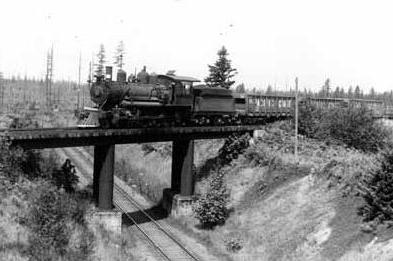Glacier Pointe History
While the Lake Sawyer and Black Diamond area was centered on logging and mining around the turn of the 20th century, the real modern history of the Glacier Pointe neighborhood started on July 2nd, 1864. It was on this date that President Abraham Lincoln signed the charter which authorized the building of a second transcontinental railroad, the Northern Pacific Railway, which was to run from Lake Superior to Puget Sound. Construction began in 1870.

When the line, which started in St. Paul Minnesota, was initally built it traversed the midwest by way of North Dakota, on to Montana to Washington and ultimately followed the Columbia River and terminated in Portland Oregon. To fulfill their charter, work continued to find a route to the Puget Sound. A path through the Cascades was forged with the creation of Stampede Pass and traversed the lowlands of western Washington by meanderering over the White River, South Prairie, then through Orting. In the mid 1880's, still not satisfied with the route, Northern Pacific dispatched a surveryor named Richard Covington to establish a shortcut, to be known as "the Palmer Cutoff", to provide a more direct path from the pass. By 1900 tracks were in place which routed the line through Kanaskat, Ravensdale, and what is now Glacier Pointe then on through Jenkins Prairie to it's terminus in Auburn. Jenkins Prairie would later become known as Covington. The famed North Coast Limited began service on April 29th, 1900.
Just past Ravensdale, the Northern Pacific tracks crossed perpendicular to the Columbia and Puget Sound Railway tracks. This area was known as Henry's Switch and has a colorful history. The C&PS tracks no longer exist but the route is clearly visible behind the Deer Ridge neighborhood, just west of Hwy 169 where the trestle in the below circa 1900 photo still stands.

In a 1970 consolidation, Northern Pacific became part of Burlington Northern Railroad which, through more mergers became Burlington Northern Santa Fe (BNSF) in 1995. The Stampede Pass line, as the tracks nearby are known, were closed in 1983 and it wasn't until 1996 that they would be used again.
Property along the tracks was sold off by the Railroad and undeveloped[1],[2],[3],[4] for nearly the entire century as logging and mining ceased and the area transformed to a growing suburb. Then in 1990 Rosewood Parke (the neighborhood across the tracks from GP) was platted. The small triangle that is Glacier Pointe was in fact 'Tract E" of Rosewood Parke.[5] This tract was never developed with the rest of Rosewood Parke and changed hands several times[6],[7] before being acquired in 2005 by Curtis Lang dba Glacier Pointe Properties LLC[8] and then Norris Homes[9] who would ultimately develop the property and build the homes.
Referenced Documents
[1] Krolls 1912 King County Property Ownership Atlas
[2] Krolls 1930 King County Property Ownership Atlas
[3] Krolls 1950 King County Property Ownership Atlas
[4] Krolls 1971 King County Property Ownership Atlas
[5] Rosewood Parke Original Plat 1990
[6] Rosewood Parke Tract E Deed July 1994
[7] Rosewood Parke Tract E Deed March 1995
The original documents which created SE 288th as a county road in 1928. Then known as J.A. McKinnon Rd.
The Pacific Railroad act at ND Studies.
Northern Pacific Railroad and Seattle Development at historylink.org
Guidebook of the Western United States: The Northern Pacific Route
More local history resources can be found on the Links page.